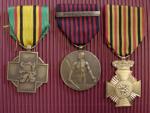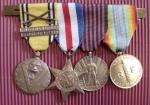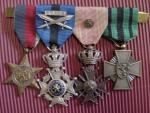-
Posts
1,116 -
Joined
-
Last visited
-
Days Won
1
Content Type
Profiles
Forums
Blogs
Gallery
Events
Store
Everything posted by Hendrik
-

Greece - WW2 Air Force Decorations
Hendrik replied to Hendrik's topic in Southern European & Balkan States
Hello Mark, Thanks for these pictures ! Cheers, Hendrik -
Hello Gents, I've taken the liberty to ask Liverpool Medals for a picture of the reverse of that "table medal" : they were showing the same picture as both obverse and reverse on their site ... curious to see if they will spot the error of identification Cheers, Hendrik
-
Current price levels on the French "market" : Legion of Honour, Officer class, 3rd Republic issue, SILVER GILT and with damage limited to a very few, near invisible enamel chips : ca. 80 Euros Same, but REAL GOLD and in pristine, near mint, condition : ca. 175 Euros So, basically, depending on quality and metal used, anything between those prices may be considered fair. Lesser quality pieces should thus be priced well below 80 Euros. Maroc Medal with Casablanca bar : ca. 50 Euros ... Cheers, Hendrik
-
Yikes ! Not hard to find in my neighbouring country of France and, without postage, I'd get three for that amount. However, they would likely be newly manufactured ones but I guess that goes for the Liverpool ones as well : no mention of anything to the contrary in their ad. Cheers, Hendrik
-
Mmmm, I beg to differ ... the Legion of Honour seems rather heavily damaged as per your description. Granted, it's an officer class but I'd personally wait till a better quality one emerges at roughly the same price level. Just my 2 (Euro-)cents worth : if there's damage, the price should be considerably lower than for a pristine one. As to the Maroc Medal and bar, if the price were in Euros and not in pounds, I'd call it a fair price. So, my conclusion : ask the seller if he's willing to take less for the pair. Just for the fun of it, I'll ask a collector friend of mine in France about the current price levels there ... Cheers, Hendrik
-

Netherlands need help to indentify medals
Hendrik replied to JRHimself's topic in Northern European & Baltic States
Dear Megan, I did consider the Portuguese one (Instru?ao Publica Order, I believe it's called) but think the one in the picture is too oval in form for it to be anything else but the French decoration. Cheers, Hendrik -

Netherlands need help to indentify medals
Hendrik replied to JRHimself's topic in Northern European & Baltic States
Hello Paul and JRH, There's no Belgian Academic Palms award - no doubt you're referring to the Palms of the Order of the Crown, which rank below the knight class of that order and thus would be too lowly an award for such a distinguished gentleman as in the picture. I'm voting for the French Academic Palms on this one ... Cheers, Hendrik -

Belgium A WW2 Evaders' Medal Group
Hendrik replied to Hendrik's topic in Northern European & Baltic States
Paul, I'm afraid there's not much more I can tell about it other than what's on my website ... the man's widow didn't have more details on that. More generally speaking, in 1943 the "usual" route to get out of Belgium to join the forces in Britain went via France, Spain and Portugal. In this case, the lads made their way under their own steam but there were also the resistance related escape lines for allied aircrew etc. that more or less followed the same direction. Those were better organized and capture in Spain was less frequent although it still occurred. Especially the "Comet Line" still has a great reputation as such an escape line - its name was derived from the speed with which aircrew were transferred to non-occupied territory. But that's an entirely different story. As to what Lievin Dewael and his friend went through, I can't even start to think what went through a 16-year old's mind when making the journey by train through occupied France - no doubt having to be very much on the alert to dodge German checkpoints and/or inspections. Then crossing the demarcation line with Vichy France and making their way over the Pyrenees mountains on foot and so forth. And all the time, in the back of their minds, knowing that being arrested by the Germans would see them end up in a German work camp ... Cheers, Hendrik -

Belgium Tsunami relief medal bar
Hendrik replied to Hendrik's topic in Northern European & Baltic States
Ha ! To save on government money I'd say ... Belgium being a tri-lingual country in which Flemish, French and German are spoken and some people being rather sensitive about it all, the obvious solution is to use English operational names when feasible with the added advantage of having to make bars in more than one language. Gone are the days when bars for "RODE DRAAK" and "DRAGON ROUGE" had to be manufactured to please those involved ... a mere "RED DRAGON" would now suffice So, all in all, just Belgian politics ... Cheers, Hendrik -

Belgium A WW2 Evaders' Medal Group
Hendrik replied to Hendrik's topic in Northern European & Baltic States
Hello Paul, Don't really know what you're after as to the "background" ... do you mean on the escape part of the story or on Belgian forces in Britain at the time or the Piron Brigade in particular ? Cheers, Hendrik -

Italy - Orders, Decorations and Medals
Hendrik replied to Hendrik's topic in Southern European & Balkan States
-

Italy - Orders, Decorations and Medals
Hendrik replied to Hendrik's topic in Southern European & Balkan States
-

Italy - Orders, Decorations and Medals
Hendrik replied to Hendrik's topic in Southern European & Balkan States
-

Italy - Orders, Decorations and Medals
Hendrik replied to Hendrik's topic in Southern European & Balkan States
Hello Gents, A few Italian Red Cross awards found their way into my collection Here goes : Long Service Cross,1st class, with "FIDELITAS" bar for civilian volunteers -
One of the latest addition to the Belgian awards : a bar for those that served in the Tsunami relief operations ... This "Tsunami Solidarity" bar is worn on the ribbon of the Commemorative Medal for Foreign Operations. Cheers, Hendrik
-
Just got hold of another source on this medal : Decorazioni e Distintivi della Croce Rossa Italiana by Alberto Galazzetti and Filippo Lombardi (ISBN 88-7364-038-9) which states the medal was created in 1916 in three classes (gold, silver and bronze) in two diametres : 28 and 22 mm. Later, in 1928, sizes were reviewed for the gold class only : 28, 22 and 18 mm. Thus, no mention of the 31.5 mm diametre ... The ribbon is white with the Italian tricolour at each edge. This type of medal was replaced by the Republic's model in 1959 Cheers, Hendrik
-

Belgium A WW2 Evaders' Medal Group
Hendrik replied to Hendrik's topic in Northern European & Baltic States
Part 3 : In a nutshell : the recipient, aged 16 at the time, not keen on possible deportation to Germany for forced labour decided to join the Belgian forces in Britain. Went through occupied France and Vichy France, crossed the Pyrenees on foot, was imprisoned in Spain but made it to Britain in the end via Portugal and Gibraltar. Was posted to a Belgian forces anti-tank company and eventually landed in Normandy exactly two months after D-Day with the Brigade Piron. Participated in the liberation of Belgium and Holland (wounded twice) and ended the war as a sergeant on the occupation force in Germany. More detailed information and some scans of documents can be found on my website : Hendrik's Medal Corner under the heading "Hall of Honours" (last item in that section). Cheers, Hendrik -

Belgium A WW2 Evaders' Medal Group
Hendrik replied to Hendrik's topic in Northern European & Baltic States
-
Hello Gents, I had the opportunity to photograph a group of medals belonging to a Belgian WW2 veteran a few days ago. Part 1 :
-
... and a little addition to this wonderful thread : THE TRIPURA 1939-1945 WAR SERVICE MEDAL Sadly without ribbon which might be yellow with red edges and a central band of of red-white-red. Cheers, Hendrik
-

France The honorary distinctions of the BROUWET COLLECTION
Hendrik replied to g_deploige's topic in France
Hello Mike, g deploige is currently on holiday till about the end of the month. I'm sure he'll react to this on his return home... Who's the person that replied to you about the invoice ? Cheers, Hendrik -
Hello Jeff & V?t?ran, I think this is the medal you are referring to ... If so, I think its award was not limited to the Carribean only and that it could be earned by prison officers in other colonies as well. Is that correct ? Cheers, Hendrik
-

Netherlands Dutch Red Cross 1940-1945 Commemorative Cross
Hendrik replied to Wilco's topic in Northern European & Baltic States
Wilco, Thanks for the background information on the clasp ! Cheers, Hendrik -

Netherlands Dutch Red Cross 1940-1945 Commemorative Cross
Hendrik replied to Wilco's topic in Northern European & Baltic States
Excellent one with the not so common bar for Indonesia ! Well done Wilco Can you give more particulars on the requirements for obtaining the bar ? Hendrik -

France The honorary distinctions of the BROUWET COLLECTION
Hendrik replied to g_deploige's topic in France
Hello Gents, Having gone to the Museum today to get my copy of it, I can vouch for the excellence of Guy's excellent book ! Cheers, Hendrik

















